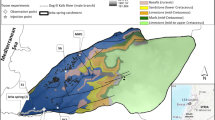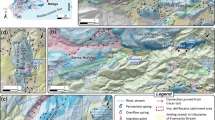Abstract
Karst aquifers are known for being particularly heterogeneous with highly transmissive conduits embedded in low permeability volumes of rock matrix. Artificial tracer experiments have been carried out in a complex karst aquifer of the folded Jura Mountains in Switzerland with the aim of deciphering the conduit organisation. It is shown that tracer experiments with multiple injection points under different flow conditions can lead to useful information on the conduits’ structure. This information has been combined with data from structural geology, spring hydrology, and speleological observations. A conceptual model of the conduit network shows that a detailed inference of the conduit organisation can be reached: geology controls conduit location and orientation; spring hydrology, including temporary springs, constrains conduit elevations and relative hydraulic heads in the aquifer subsystems; and tracer tests identify major flow paths and outlets of the system and dilution caused by non-traced tributaries, as well as the presence of secondary flow routes. This understanding of the Aubonne aquifer structure has important implications for the future management of the groundwater resource. Similar approaches coupling geological information, spring hydrology, and multi-tracer tests under various flow conditions may help to characterise the structure of the conduit network in karst aquifers.
Résumé
Les aquifères karstiques se caractérisent par leur forte hétérogénéité créée par quelques conduits très transmissifs englobés dans des volumes de roche peu perméables. Des essais de traçage artificiels ont été réalisés au sein d’un système karstique du Jura plissé (Suisse) dans le but de déterminer l’organisation des conduits. Les résultats montrent que des essais de traçage avec plusieurs points d’injection sous différentes conditions hydrodynamiques fournissent des informations utiles sur l’agencement des conduits. Ces informations ont été combinées avec des données de géologie structurale, le fonctionnement hydrodynamique des différentes sources du système et des observations spéléologiques. L’organisation de ces conduits peut être estimée avec une certaine précision et un modèle conceptuel du réseau de conduits est proposé : la géologie contrôle la position et l’orientation des conduits ; le fonctionnement des sources, incluant les sources temporaires, détermine l’élévation des conduits et les charges hydrauliques dans les différents compartiments de l’aquifère ; les essais de traçage permettent d’identifier les écoulements principaux, les différentes sources du système, les dilutions créées par des affluents non tracés et l’existence d’écoulements secondaires. Cette compréhension de la structure de l’aquifère de l’Aubonne a des implications importantes dans le cadre de la gestion future de cette ressource en eau. Des approches similaires, couplant des informations géologiques, le fonctionnement des sources et des essais de traçage sous des conditions hydrodynamiques différentes peuvent efficacement caractériser l’organisation du réseau de conduits des aquifères karstiques.
Resumen
Se sabe que los acuíferos cársticos son particularmente heterogéneos, con conductos de alta transmisividad incluidos en grandes volúmenes de matriz rocosa de baja permeabilidad. Con el objetivo de descifrar la organización de tales conductos, se han llevado a cabo ensayos de trazadores artificiales en un acuífero cárstico complejo de las montañas Jura en Suiza. Se muestra que los experimentos con trazadores y múltiples puntos de inyección, bajo diferentes condiciones de flujo, pueden proporcionar información muy útil sobre la estructura de los conductos. Tal información se ha combinado con datos de la estructura geológica, la hidrología de manantiales, y con observaciones espeleológicas. Se demuestra que puede lograrse un modelo conceptual de la red de conductos con inferencias detalladas de la organización de tales conductos: la geología controla la localización y orientación de los conductos; la hidrología de los manantiales, incluso los de régimen temporario, condiciona la elevación de los conductos y los niveles de agua en los subsistemas acuíferos; y los ensayos de trazadores identifican las principales vías de flujo y salidas de agua, dilución originada en tributarios no involucrados en el ensayo, al igual que rutas secundarias del flujo. La comprensión de la estructura del acuífero Aubonne tiene importantes implicancias para el manejo futuro de los recursos hídricos subterráneos. Aproximaciones metodológicas de este tipo, vinculando información geológica, hidrología de manantiales, y ensayos de trazadores múltiples bajo condiciones de flujo variable podrían ayudar a caracterizar la estructura de la red de conductos en acuíferos cársticos.









Similar content being viewed by others
References
Atkinson TC, Smith DI, Lavis JJ, Whitaker RJ (1973) Experiments in tracing underground waters in limestone. J Hydrol 19(4):323–349
Audétat M, Heiss G, Christen D, Deriaz P, Heiss C, Luetscher M, Morel P, Perrin J, Wittwer M (2002) Inventaire spéléologique du Jura vaudois, partie ouest [Inventory of caves located in the Jura Mountains, western Switzerland, Vaud county]. Commission spéléologique de l’Académie Suisse des Sciences Naturelles, La Chaux-de-Fonds, Switzerland
Birk S, Geyer T, Liedl R, Sauter M (2005) Process-based interpretation of tracer tests in carbonate aquifers. Ground Water 43(3):381–388
Chatwin PC (1971) On the interpretation of some longitudinal dispersion experiments. J Fluid Mech 48(4):669–702
COST Action 620 (2004) Vulnerability and risk mapping for the protection of carbonate (karst) aquifers. Final Report, EC Directorate-General for Research EUR 20912, Luxemburg, 297 pp
Field MS (2002) The QTRACER2 program for tracer-breakthrough curve analysis for tracer tests in karstic aquifers and other hydrologic systems. USEPA, Washington, DC
Field MS, Pinsky PF (2000) A two-region nonequilibrium model for solute transport in solution conduits in karstic aquifers. J Contam Hydrol 44(3–4):329–351
Ford D, Williams P (2007) Karst hydrogeology and geomorphology. Wiley, Chichester, UK
Geyer T, Birk S, Licha T, Liedl R, Sauter M (2007) Multitracer test approach to characterize reactive transport in karst aquifers. Ground Water 45(1):36–45
Goldscheider N (2005) Fold structure and underground drainage pattern in the alpine karst system Hochifen-Gottesacker. Eclogae Geol Helv 98:1–17
Hauns M, Jeannin P-Y, Atteia O (2001) Dispersion, retardation and scale effect in tracer breakthrough curves in karst conduits. J Hydrol 241(3–4):177–193
Häuselmann P, Jeannin P-Y, Bitterli T (1999) Relationships between karst and tectonics: case-study of the cave system north of Lake Thun (Bern, Switzerland). Geodin Acta 12:377–387
Herold T, Jordan P, Zwahlen F (2000) The influence of tectonic structures on karst flow patterns in karstified limestones and aquitards in the Jura Mountains, Switzerland. Eclogae Geol Helv 93:349–362
Kass W (1998) Tracing technique in geohydrology. Balkema, Rotterdam, The Netherlands, 581 pp
Lavanchy Y, SCVJ (1987) Réalisation d’un essai de traçage triple dans la région du Mont-Tendre-Col du Mollendruz (Jura vaudois) [Triple tracing experiment realised in the Mont Tendre-Mollendruz region, western Swiss Jura]. Actes du 8ème Congrès National de Spéléologie, La Chaux-de-Fonds, Switzerland, Stalactite, Supplement no.12, pp 97–103
Luetscher M, Perrin J (2001) Multitraçage dans la région du Noirmont (Jura vaudois), résultats préliminaires [First results of a multitracing experiment realised in Noirmont region, Swiss Jura, Vaud County]. Actes 11ème Congrès National de Spéléologie, Geneva, September 2001, pp 107–110
Luetscher M, Perrin J (2005) The Aubonne karst aquifer (Swiss Jura). Eclogae Geol Helv 98:237–248
Maloszewski P, Zuber A (1990) Mathematical modeling of tracer behavior in short-term experiments in fissured rocks. Water Resour Res 26(7):1517–1528
Massei N, Wang HQ, Field MS, Dupont JP, Bakalowicz M, Rodet J (2006) Interpreting tracer breakthrough tailing in a conduit-dominated karstic aquifer. Hydrogeol J 14:849–858
Morales T, Valderrama IF, Uriarte JA, Antiguedad I, Olazar M (2007) Predicting travel times and transport characterisation in karst conduits by analysing tracer-breakthrough curves. J Hydrol 334:183–198
Palmer AN (1991) The origin and morphology of limestone caves. Geol Soc Am Bull 103:1–21
Palmer AN (2003) Speleogenesis in carbonate rocks. In: Gabrovsek F (ed) Evolution of karst: from prekarst to cessation, Postojna, Ljubljana, Slovenia, pp 43–60
Perrin J, Luetscher M (2001) Observations géologiques et hydrogéologiques dans les gouffres de Longirod et du Narcoleptique (Jura vaudois) [Geological and hydrogeological observations in Longirod and Narcoleptique caves, Swiss Jura, Vaud county]. Actes 11ème Congrès National de Spéléologie, Geneva, September 2001, pp 99–106
Perrin J, Pochon A, Jeannin P-Y, Zwahlen F (2004) Vulnerability assessment in karstic areas: validation by field experiments. Environ Geol 46(2):237–245
Rossier Y, Kiraly L (1992) Effet de la dilution sur la détermination des dispersivités par interprétation des essais de traçage dans les aquifères karstiques [Role of dilution on the estimation of dispersivities based on the interpretation of tracer tests carried out in karst aquifers]. Bull Centre Hydrogéol Neuchâtel 11:1–15
Schnegg P-A (2002) An inexpensive field fluorometer for hydrogeological tracer tests with three tracers and turbidity measurements. Proceedings of the XXXII IAH and ALHSUD Congress, Mar del Plata, October 2002, pp 1484–1488
Seiler KP, Maloszewski P, Behrens H (1989) Hydrodynamic dispersion in karstified limestones and dolomites in the Upper Jurassic of the Franconian Alb. J Hydrol 108:235–247
Smart CC (1988a) Artificial tracer techniques for the determination of the structure of conduit aquifers. Ground Water 26(4):445–453
Smart CC (1988b) Quantitative tracing of the Maligne karst system, Alberta, Canada. J Hydrol 98:185–204
Smart CC, Zabo L (1997) Experimental design, technique and protocol in fluorometric tracing of ground water. Proc. 6th Conference on Limestone Hydrology and Fissured Media, La Chaux-de-Fonds, Switzerland, August 1997, pp 51–54
Wenk HR, Wenk E (1969) Physical constants of alpine rocks (density, porosity, specific heat, thermal diffusivity and conductivity). Schweizer Mineral Petrogr Mitteil 49(2):343–357
Werner A, Hötzl H, Käss W (1997) The interpretation of a high water tracer test in the Danube-Aach System (western Swabian Alb, Germany). Proc. 6th Conference on Limestone Hydrology and Fissured Media, La Chaux-de-Fonds, Switzerland, Limestone Hydrology and Fissured Media, La Chaux-de-Fonds, Switzerland, pp 187–190
Werner A, Hötzl H, Maloszewski P, Käss W (1998) Interpretation of tracer tests in karst systems with unsteady flow conditions. In: Proc. Workshop Karst Hydrology, Rabat, Morocco, 23 April–3 May 1997, IAHS Publ 247, IAHS, Wallingford, UK, pp 15–26
White WB (1988) Geomorphology and hydrology of karst terrains. Oxford University Press, Oxford
White WB (2002) Karst hydrology: recent developments and open questions. Eng Geol 65(2–3):85–105
Worthington SRH (2001) Depth of conduit flow in unconfined carbonate aquifers. Geology 29(4):335–338
Acknowledgements
We are grateful to the cavers of the Swiss Speleological Society for their help during the field data acquisition. We also thank Prof. A. Parriaux and A. Tomaniak, from the Geology laboratory at Ecole Polytechnique Federale Lausanne (EPFL) who kindly provided the discharge data of Malagne spring and facilitated the access to their archives. Prof. P. Smart is acknowledged for his helpful comments and edits. The study has been greatly facilitated by the technical support of the Centre for Hydrogeology of Neuchâtel (CHYN) and the financial support of the municipalities of Le Chenit, Gland, Montricher, Bursins, Arzier, Genolier, Aubonne as well as SEFA (Société électrique des forces de l’Aubonne) and the Scientific Commission of the Swiss Speleological Society. We also thank the two anonymous reviewers, the Managing Editor Prof. C. Simmons and the Technical Editorial Advisor Sue Duncan for their comments, which significantly improved the manuscript.
Author information
Authors and Affiliations
Corresponding author
Rights and permissions
About this article
Cite this article
Perrin, J., Luetscher, M. Inference of the structure of karst conduits using quantitative tracer tests and geological information: example of the Swiss Jura. Hydrogeol J 16, 951–967 (2008). https://doi.org/10.1007/s10040-008-0281-6
Received:
Accepted:
Published:
Issue Date:
DOI: https://doi.org/10.1007/s10040-008-0281-6




